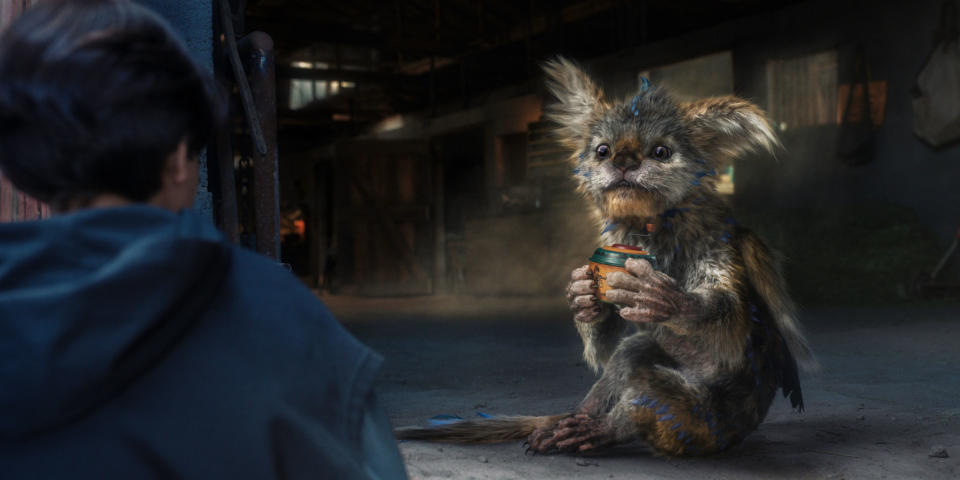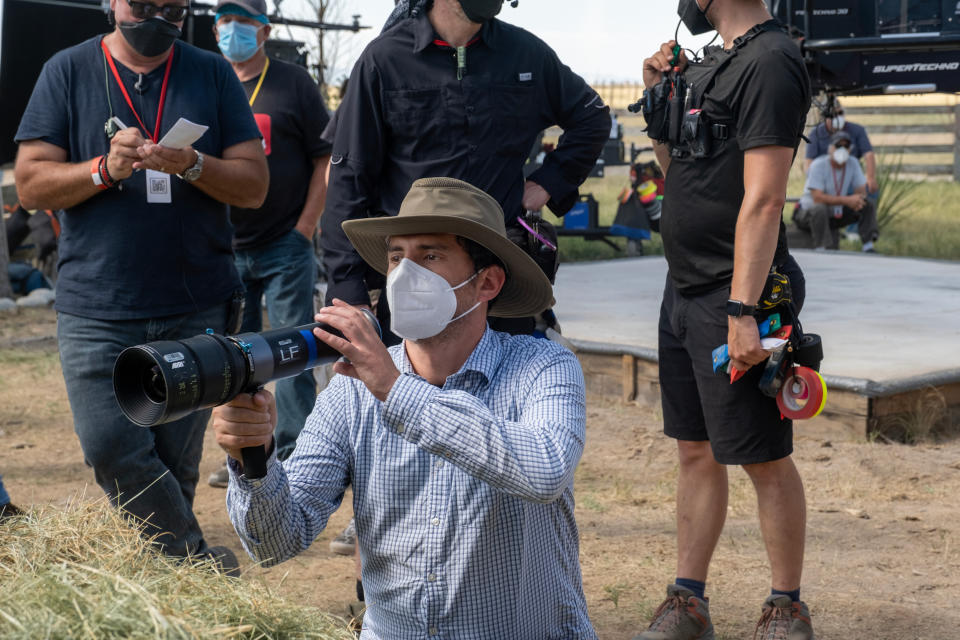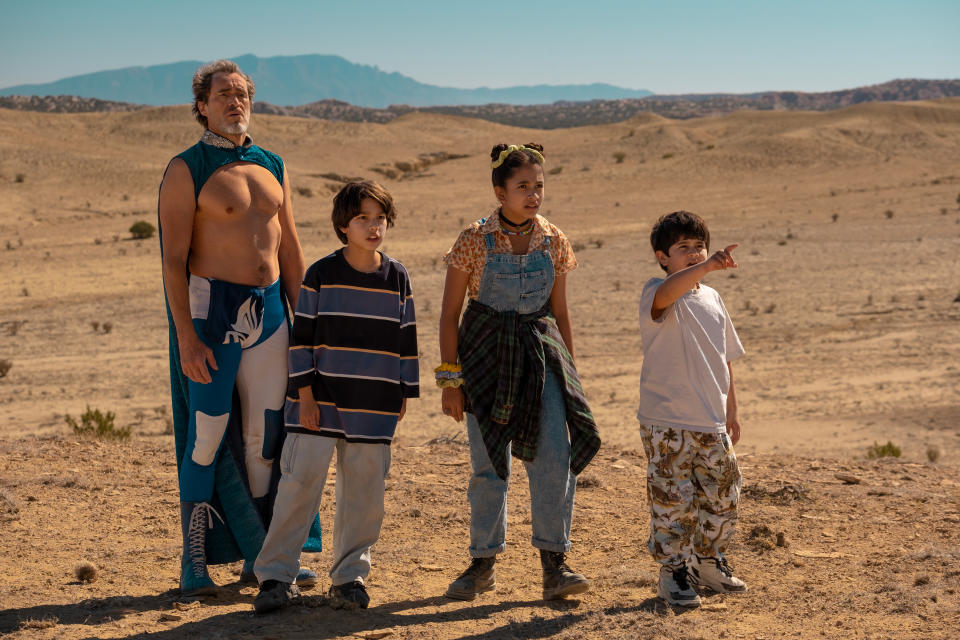‘Chupa’: New film explores the famous Latin American creature with a family-friendly twist
Stories of a mysterious blood-sucking creature killing goats and livestock have been told for decades, haunting the dreams of Latin American children — mine included.
The first chupacabra, or “goat sucker,” sighting was first reported in the mid-90s in Puerto Rico, per PBS. Since then, the creature has become part of Latin American folklore and pop culture.
In the latest on-screen depiction, director Jonás Cuarón gives the frightful fairytale monster a family-friendly twist in “Chupa.”
Set in 1996, “Chupa” follows a shy 13-year-old boy named Alex (Evan Whitten) who flies from Kansas City to Mexico to visit his extended family for the first time. Once there, he discovers and befriends a chupacabra cub hiding in his grandfather's shed.
The twist? His grandfather, former Lucha Libre champion Chava (Demián Bichir), has a secret history with the creature and has been protecting Chupa from scientist Richard Quinn (Christian Slater).
Cuarón tells TODAY.com that he was a teen when the myth started and “quickly spread all over Latin America.”
“Where I was living in Mexico, there started to be a lot of news about the chupacabras. I became very excited because there was something scary but also very exciting about the possibility of a real creature being outside,” he says. “Unlike Bigfoot and the Loch Ness Monster, which were all legends, the fact that the chupacabra was a new legend when I was a kid, made it more believable.”
But what’s the story behind the legendary creature? Read on to find out more.
What is a chupacabra?
A chupacabra is a legendary creature from folklore in Latin America. The Spanish word translates to “goatsucker” with “chupa” meaning “to suck” and “cabra” meaning “goat.”
The legend stems from reports of farm animals and pets’ blood being drained.
Over the years, chupacabras have been described as “mangy coyotes, dogs, and coyote-dog hybrids, or coydogs,” according to Loren Coleman, director of the International Cryptozoology Museum in Portland, Maine.
“In 1995 chupacabras was understood to be a bipedal creature that was three feet tall and covered in short gray hair, with spikes out of its back,” Coleman told National Geographic. However, some reports also described the creature as walking on four legs, having wings like a bat, fangs and a hunched back with large black or red eyes, per PBS' series “Monstrum.”
As the years went by, depictions changed due to mistakes and mistranslations in news reports, Coleman said.
Where did the creature originate from?
The first reports of a chupacabra appeared in 1995 in Canóvanas, Puerto Rico, after “dozens” of farm animals were found dead, per PBS. What made these deaths unique was that it appeared as though their blood had apparently been sucked dry by small perforations in the neck and abdomen.
By April 1996, reported sightings had spread throughout the island and more than 2,000 animals had allegedly been killed by chupacabras.
The Puerto Rican government then stepped in bringing in biologists to research the deaths after concern grew across the county and fear that it would negatively impact its tourism, the public broadcaster said.
Reports of chupacabras would later extend to Mexico, the U.S. southwest and China.
The myth explained
While sightings continued to be reported, scientists believed the chupacabras were coyotes suffering from severe cases of mange, according to National Geographic. Photos of shriveled up animals have also surfaced online, only adding to the myth.
Barry OConnor, an emeritus professor at the University of Michigan who specializes in parasitic mites, tells TODAY.com that sarcoptic mange is a disease caused by parasitic mites that can affect dog-like animals. When affected, it can cause them to itch, lead to their hair falling out, their skin becoming thick and crusty, and the development of painful sores.
OConnor says that coyotes with mange might have a harder time catching their prey because of the effects, which can debilitate them and “severely affect their ability to hunt.”
“If a predator like that is really unable to hunt its normal prey, it will go after anything that it can,” he says. “If a domestic dog, cat, sheep, whatever it is, is available and not able to get away, then they’ll take it or they’ll try to kill it.”
As far as chupacabras having fangs, OConner says one of the results of the mange condition is that the skin around the face and the mouth will get tight and pull back from the lip, exposing the teeth.
“This gnarly face is quite typical of a mangy animal,” he says. “It’s not that they’re actually snarling, it’s that their skin is pulled away from their lips, they’re pulled away from their teeth.”
To the untrained eye, a photo of an animal suffering from a severe case of mange could easily be confused with another creature.
“Somebody who’s unfamiliar with the condition, somebody who is in a culture where that legend is there, yeah, they’re gonna see something like that and put two and two together,” OConner says. “And maybe say, ‘Yeah, I saw one of those (chupacabras.)”
“Every picture I ever saw, it was very clearly an animal with sarcoptic mange,” he adds.
As for those reports of a chupacabra draining the blood from its victims, OConner says, “That’s the one thing that is way off there.”
What are some references of the chupacabra in pop culture?
Most depictions of the chupacabra are terrifying ones.
“The X-Files” touched on the mythological creature in Season Four, episode 11 titled “El Mundo Gira.” Released on January 12, 1997, it showed Mulder and Scully trailing a chupacabra, only to discover a fungal growth affecting immigrants.
There was also a chupacabra storyline in a 2001 episode titled “The Curse of El Chupacabra” of “Jackie Chan Adventures,” and in the 2014 midseason finale of Season Four of “Grimm.” In an an Easter-themed 2012 episode, “South Park” poked fun at the beast.
In 2021, Randy Rogers Band and La Maquinaria teamed up to release a song inspired by the creature called “Chupacabra.”
How is a chupacabra represented in "Chupa"?
Cuarón wanted to play with “the reversal of the myth" and remove the horror surrounding the beast.
“Chupa is a cub, but he’s like a baby chupacabra,” he tells TODAY.com. “We wanted to make him vulnerable and very adorable. I wanted to create a similar reaction with the kids as Gizmo (from ‘Gremlins’) did with me.”
While the director “immediately fell in love with Gizmo,” he knew that the tiny terror was powerful and had a family who were “big creatures that are more threatening.” “Similar to the play that you see in ‘Gremlins’ where you see Gizmo, adorable, but if he eats after midnight he turns terrifying.”
Inspired by "Gremlins" and "E.T.", the director focused on two elements to create Chupa.

“In many of the sightings they describe it as a quadruped... and they also, certain sightings, described the chupacabras as having wings, which I always thought was interesting,” he says. “But on the other hand, I really wanted it to be a creature that kids and the character of Alex could really have an emotional connection with.”
He thought about animals that kids have an innate connection with to create the final design of Chupa, adding that they used a real dog to film Chupa’s scenes.
“Whenever you see Alex interacting with Chupa, he was really interacting with the dog Harper,” he reveals. “Because to me, it was really important to have Alex have a real creature to interact with.”
What inspired Jonás Cuarón for a family-friendly version?
The Mexican director and writer’s main inspiration were his kids and being able to share his work with them.
“I basically did ‘Chupa’ for them,” he says. “I spent all of the pandemic watching movies with them and a lot of the movies we watched were movies from my childhood like ‘E.T’ and ‘Gremlins’ and ‘Goonies.’ And then suddenly coming from doing action-thrillers, I suddenly got the urge to do something that I could share with them that would create that sensation of magic that those old movies from my childhood had created in me.”
He also enjoyed the idea of tapping into a legend that he was familiar with. “I was excited because I knew I could do a movie for family audiences but that I could also ground in a reality I knew,” he says.

There's more to "Chupa" then a fictional creature
Actor Demián Bichir grew up hearing the stories of chupacabras but was never “good at buying bizarre stories,” he tells TODAY.com. “I remember the first time I heard it, it was crazy. I thought, 'Oh dear, another crisis, another lie.’”
However, he thought the story of "Chupa" was "genius." He says that there were many factors that attracted him to the film, including starring alongside Christian Slater, working with Cuarón, and portraying a multi-layered character.
He’s also never played a grandfather, “That alone is great.”
“I know those people who grow strong and become older gracefully and (are) still in shape, especially former athletes,” Bichir says of his character Chava, a former luchador. “There’s a lot of my dad in the character I created because he is like that.”

The fundamental message of the movie, Cuarón says, is the importance of family and reconnecting with your roots.
“It is at its core a movie about family. I think it’s also beyond that,” he says. “I really think it’s about the purity of a relationship between a boy and a creature.”
Bichir agrees, echoing that “Chupa” shows how family — whether its biological or a mythical creature — will always be there for you.
“We’ll get your back under any circumstance,” the actor says. “And heritage is important, and going back to your roots is very important to know who you are to have a better brighter future.”
“Chupa” is now streaming on Netflix.
This article was originally published on TODAY.com

